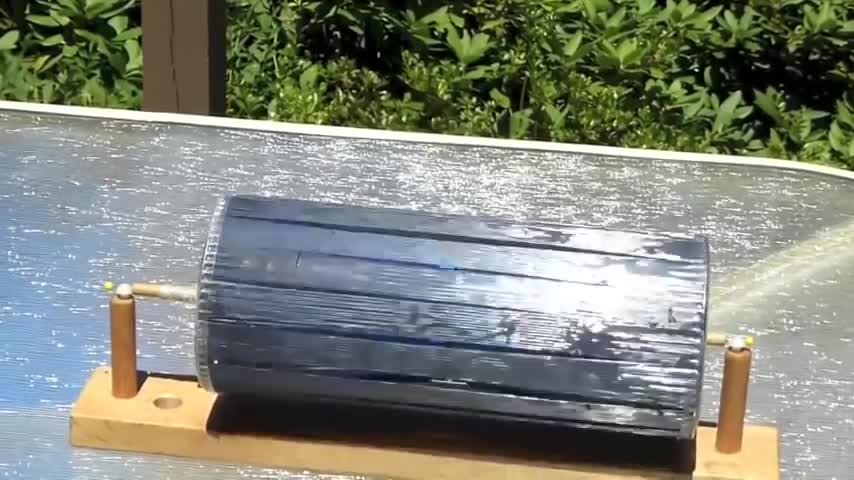Premium Only Content

Solar motor--Free energy motor-- not electrical /// Homemade Science
These devices are sometimes referred to as solar motors or thermal motors, or even thermal retraction motors. Sunlight hitting the strips is converted into thermal energy (heat) which then causes the rotor to turn without any electrical or other mechanical parts. The use of the term "free energy" in this context means that this device is converting energy that is "freely" supplied by our sun and is not meant to suggest that it violates any laws of thermodynamics, or that it is creating energy. Sunlight, wind, geothermal and damming water can all be thought of as deriving energy from "free" sources.
Do you wish to find out more info? Join the free energy group on telegram, we are relaunching it with zero tolerance towards spam: https://t.me/FreeEnergyTelegram
Every electronic equipment generates harmfull EMF radiations, learn more about protection against them here: https://dq271.isrefer.com/go/5GEMF/AUL651/
The earliest versions of these types of motors used rubber bands as the ribs. The movement of this motor is dependent on the unique property of the stretched trash bag strips. These strips are made from a plastic material called polyethylene. This chemical is a common example of a polymer. One of its characteristics is that it is made of very long molecular chains. Thin strips were cut out of a trash bag parallel to the top of the bag and then pulled, stretching the plastic about 5 times it's original length. The long polymer molecules are stretched to their elastic limit during the stretching process. If more force is applied, these long chains are broken when the plastic tears apart. When heating the strips, the polymer molecule chains contract, pulling the molecules closer together in a process called thermal retraction. They do not expand due to cooling as some students may suggest. The action of the polyethylene retracting or shrinking is quite different from a uniform expansion of matter as a result of kinetic energy. As this plastic is heated temporarily, the material pulls tighter and shrinks to a smaller size. The plastic remains “shrunken” until pressure is applied to stretch the molecular chains out again.
The movement of the motor is due to the materials at the top of the cup assembly contracting slightly; this action is pulling the cups together at the top. The action is not noticeable since it is so slight. It is noticeable if the plastic is heated sufficiently but too much heat may damage the rotor . As the cups are pulled together, the assembly becomes unbalanced. The motor is now top heavy and starts to turn and fall toward the bottom. As the assembly turns, a new section is then exposed to light and is heated. This new spot becomes top heavy causing this section to fall. The action is continually repeated making the top section always unbalanced; the cups are constantly trying to adjust to become balanced. The end result is the motor turning because it is trying to right itself. The highest speed for the cups in direct summer sunlight seems to top out around 65 RPMs.
The addition of mass to the flywheel directions has some benefits and drawbacks. This addition can make the cup more efficient, but it will not make it spin faster. The “good news” is that adding mass to the flywheel can enable this tiny motor to perform small tasks, however, it does not make it efficient enough that it can turn a small generator. This design simply does not generate torque to do so.
The "bad news" is that as more mass is added to the flywheel, it becomes more finicky and will require more adjustments for balancing.
Other videos are in the works so please subscribe and if you like what you see, let me know. Thanks
Homemade science is a collection of classroom tested ideas, suggestions, projects, and experiments that I have used in teaching physical science for the Annville-Cleona school district in central Pennsylvania. I am currently in my 40th year of teaching. My intention is to share these ideas with other teachers or anyone who has an interest in science. I have found that designing and building my own equipment has taught me more than any course that I have ever taken. I hope that you consider making or trying these experiments for yourself.
-
 1:23:41
1:23:41
Game On!
18 hours ago $5.21 earnedNetflix NFL Christmas Games Preview and Predictions!
29K5 -
 2:05:07
2:05:07
Darkhorse Podcast
22 hours agoWhy Trump Wants Greenland: The 257th Evolutionary Lens with Bret Weinstein and Heather Heying
265K419 -
 8:50:58
8:50:58
Right Side Broadcasting Network
22 hours ago🎅 LIVE: Tracking Santa on Christmas Eve 2024 NORAD Santa Tracker 🎅
289K37 -
 2:48
2:48
Steven Crowder
1 day agoCROWDER CLASSICS: What’s This? | Nightmare Before Kwanzaa (Nightmare Before Christmas Parody)
271K12 -
 33:49
33:49
Quite Frankly
21 hours agoThe Christmas Eve Midnight Telethon
83.6K11 -
 2:12:46
2:12:46
Price of Reason
20 hours agoAmber Heard BACKS Blake Lively Lawsuit Against Justin Baldoni! Is Disney CEO Bob Iger in TROUBLE?
44.6K13 -
 1:01:17
1:01:17
The StoneZONE with Roger Stone
15 hours agoChristmas Edition: Why the Panama Canal is Part of the America First Agenda | The StoneZONE
117K44 -
 18:12:15
18:12:15
LFA TV
1 day agoLFA TV CHRISTMAS EVE REPLAY
133K14 -
 13:32
13:32
Scammer Payback
16 hours agoChanging the Scammer's Desktop Background to his Location
6.35K3 -
 4:21
4:21
BIG NEM
18 hours agoNikola Tesla's Secret to Cultivating Creativity & Genius
4.14K1